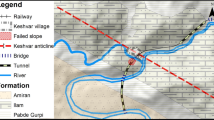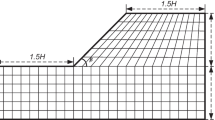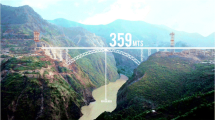Abstract
Estimating the mechanical properties of a rock mass is an inherently complex task involving numerous uncertainties, especially when performing rock slope stability analysis. Conventional rock mass classification systems with essential adjustments to account for rock discontinuities are a feasible approach to analyzing rock slope stability. Moreover, back analysis of a failed or failing slope can be used as a reliable method of determining the shear strength parameters of rock joints. In this work, the slope stability of Karoun trench was analyzed and its geomechanical parameters were estimated, focusing on the slope mass rating (SMR) and utilizing the back-analysis method. SMR was employed to evaluate the stability of the trench. Numerical simulations were then carried out using the Universal Distinct Element Code software package in order to perform back analysis, thus allowing the mechanical properties of the rock slope to be predicted. Although simpler methods of determining slope instability may be available, the authors wished to focus purely on the capabilities of the SMR and the back-analysis method. The results indicate that the modified SMR is a reliable method for the primary assessment of rock slope stability and for identifying the critical failure mode. Moreover, sliding on bedding planes is the dominant failure mode, and the properties of the discontinuities play a key role in the instability of the considered rock slope.










Similar content being viewed by others
References
Akgun A (2011) Assessment of possible damaged areas due to landslide-induced waves at a constructed reservoir using empirical approaches: Kurtun (North Turkey) Dam reservoir area. Nat Hazard Earth Syst Sci 11:1341–1350
Alejano LR, Ferrero AM, Alvarez Fernandez P, Ramirez-Oyanguren MI (2011) Comparison of limit-equilibrium, numerical and physical models of wall slope stability. Int J Rock Mech Min Sci 48:16–26
Anbalagan R, Sharma S, Raghuvanshi TK (1992) Rock mass stability evaluation using modified SMR approach. In: Proc 6th Natl Symp on Rock Mechanics, Bangalore, India, 15–17 Oct 1992, pp 258–268
Barton N, Lien R, Lunde J (1974) Engineering classification of masses for the design of tunnel support. Rock Mech 6(4):189–236
Bieniawski ZT (1973) Engineering classification of jointed rock masses. Trans S Afr Inst Civ Eng 15:335–344
Bieniawski ZT (1979) A comparison of rock mass deformability measurements by different methods. In: Proc Rapid Excavation and Tunnelling Conf, New York, USA, pp 901–916
Bieniawski ZT (1989) Engineering rock mass classifications: a complete manual for engineers and geologists in mining, civil and petroleum engineering. Wiley, New York
Chen Z (1995) Recent developments in slope stability analysis. In: Proc 8th ISRM Congr, Tokyo, Japan, 25–29 Sept 1995, pp 1041–1048
Corominas J, Mavrouli O (2009) Evaluation of the susceptibility to failure of rocky slopes based on the SMR index. In: Proc Int Conf “Landslide Processes,” Strasbourg, France, 6–7 Feb 2009, pp 271–276
Culshaw MG (2007) Communicating the risks arising from geohazards. In: CLIFFS Workshop, Loughborough, UK, 3 July 2007
Dawson EM, Roth WH, Drescher A (1999) Slope stability analysis by strength reduction. Geotechnique 49(6):835–840
Dawson E, Motamed F, Nesarajah S, Roth W (2000) Geotechnical stability analysis by strength reduction. Slope Stability 2000:99–113
Djakamihardja AS, Soebowo E (2000) The application of rock mass rating and slope mass rating on slope cutting at a section of Liwa–Krui roadway, Sumatera, Indonesia. In: GeoEng 2000, Melbourne, Australia, 19–24 Nov 2000, ISBN 1-58716-068-4
Duran A, Douglas K (2000) Experience with empirical rock slope design. In: GeoEng 2000, Melbourne, Australia, 19–24 Nov 2000, ISBN 1-58716-068-4
Eberhardt E, Thuro K, Luginbuehl M (2005) Slope instability mechanisms in dipping interbedded conglomerates and weathered marls—the 1999 Rufi landslide Switzerland. Eng Geol 77:35–56
Fatemi SAA (2002) Design of Karoun slopes considering ground water and permeability. MSc Thesis. Department of Rock Mechanics Engineering and Mining, Tarbiat Modarres University, Iran (in Persian)
Fernandes de Carvalho R, Antunes do Carmo JS (2006) Numerical and experimental modelling of the generation and propagation of waves caused by landslides into reservoirs and their effects on dams. Taylor and Francis, London, pp 483–492
Fernandes de Carvalho R, Antunes do Carmo JS (2007) Landslides into reservoirs and their impacts on banks. Environ Fluid Mech 7:481–493
Fernandes de Carvalho R, Antunes do Carmo JS, Pestana A (2006) Chapter 20: Waves caused by landslides into reservoirs and their impacts on dams. In: Matos J, Chanson H (eds) Hydraulic structures: a challenge to engineers and researchers. The University of Queensland, Brisbane, pp 125–134
Gazviniyan AH, Khakbaz MR, Behnia M (2007) Interpretation and analysis of the results of in situ shear tests on planar discontinuities, particularly MJ28 discontinuities in the left hand bank of Karoun 4 Dam. In: 3rd Iranian Conf on Rock Mechanics, Tehran, Iran, 16–18 Oct 2007 (in Persian)
Gibson AD, Culshaw MG, Dashwood C, Pennington CVL (2013) Landslide management in the UK—the problem of managing hazards in a “low-risk” environment. Landslides 10:599–610
Hack R (1998) Slope stability probability classification (SSPC). Ph.D. dissertation. Delft University of Technology, Delft
Hack R (2002) An evaluation of slope stability classification. In: Proc ISRM Int Symp EUROCK, 25–28 Nov 2002, Funchal, Portugal, pp 1–32
Hack R, Price D, Rengers N (2003) A new approach to rock slope stability: a probability classification (SSPC). Bull Eng Geol Environ 62:167–184
Hoek E (2007) Practical rock engineering. Rocscience, Toronto
Hoek E, Kaiser PK, Bawden WF (1995) Support of under-ground excavations in hard rock. Balkema, Rotterdam
Irigaray C, Fernandez T, Chacon J (2003) Preliminary rock-slope-susceptibility assessment using GIS and the SMR classification. Nat Hazards 30:309–324
Itasca (2004) UDEC: Universal Distinct Element Code, version 4.0. Itasca Inc., Minneapolis
Jaeger C (1979) Rock mechanics and engineering, 2nd edn. Cambridge University Press, Cambridge, p 523
Kafle RK (2010) Slope mass rating in middle mountain of Nepal: a case study on landslide at Rabi VDC Opi village. J Sci Eng Technol 6(2):28–38
Khakbaz M (2002) In-situ geomechanical investigation of the rock masses of Karoun-4 dam. In: 1st Iranian Conf on Rock Mechanics, 29–30 Jan 2002, pp 3–13
Laubscher DHA (1990) Geomechanical classification system for the rating of rock mass in mine design. J South Afr Inst Min Metal 90(10):257–273
Lindsay P, Campbell RN, Fergusson DA, Gillard GR, Moore TA (2001) Slope stability probability classification, Waikato Coal Measures, New Zealand. Int J Coal Geol 45:127–145
Nicholson DT (2000) Deterioration of excavation rock slopes: mechanism, morphology and assessment. PhD Dissertation. School of Earth Science, University of Leeds, Leeds
Nicholson DT, Hencher S (1997) Assessing the potential for deterioration of engineered rock slopes. In: Marinos PG, Koukis GC, Tsiambaos GC, Stoumaras GC (eds) Engineering geology and the environment. Balkema. Rotterdam, pp 911–917
Nilsen B (2000) New trends in rock slope stability analyses. Bull Eng Geol Environ 58:173–178
Pantelidis L (2009) Rock slope stability assessment through rock mass classification systems. Int J Rock Mech Min Sci 46:315–325
Pantelidis L (2010) An alternative rock mass classification system for rock slopes. Bull Eng Geol Environ 69(1):29-39. doi:10.1007/s10064-009-0241-y
Robertson AM (1988) Estimating weak rock strength. In: AIME Annual General Meeting, Tucson, AZ, USA, Jan 1988, pp 1–6
Romana M (1985) New adjustment ratings for application of Bieniawski classification to slopes. In: Proceedings of the International Symposium on the Role of Rock Mechanics in Excavations for Mining and Civil Works. International Society of Rock Mechanics, Zacatecas, pp 49–53
Romana M (1991) SMR classification. In: 7th ISRM Congr, Aachen, Germany, 16–20 Sept 1991, pp 995–960
Romana M (1993) A geomechanical classification for slopes: slope mass rating. In: Hudson JA (ed) Comprehensive rock engineering: principles, practice and projects. Vol 3: Rock testing and site characterisation. Pergamon, Oxford, 575–599
Romana M (1995) The geomechanical classification SMR for slope correction. In: 8th ISRM Congr, Tokyo, Japan, 25–29 Sept 1995, pp 1085–1092
Romana M, Serón JB, Montalar E (2003) SMR geomechanics classification: application, experience and validation. In: ISRM 2003–Technology Roadmap for Rock Mechanics, 8–12 September 2003, Gauteng, South Africa, pp 1–4
Rosenbaum MS, Culshaw MG (2003) Communicating the risks arising from geohazards. J R Stat Soc A 166(2):261–270
Salim A (2010) Mechanisms of rock mass behaviour associated with slope instability. MSc thesis. University of the Witwatersrand, Johannesburg
Selby MJ (1980) A rock mass strength classification for geomorphic purposes: with tests from Antarctica and New Zealand. Z Geomorphol 24:31–51
Sen Z, Sadagah BH (2003) Modified rock mass classification system by continuous rating. Eng Geol 67:269–280
Sharifzadeh M, Sharifi M, Darabi SM (2010) Back analysis of an excavated slope failure in highly fractured rock mass: the case study of Kargar slope failure (Iran). Environ Earth Sci 60:183–192. doi:10.1007/s12665-009-0178-2
Singh B, Goel RK (2011) Engineering rock mass classification—tunnelling, foundations and landslides. Elsevier, Amsterdam, 18:231–243
Singh RN, Brown DJ, Denby B, Croghan JA (1986) The development of a new approach to slope stability assessment in UK. In: Ground Movement and Control Related to Coal Mining Symp, Wollongong, Australia, Aug 1986, pp 59–63
Singh B, Goel RK, Mehrotra VK, Garg SK, Allu MR (1998) Effect of intermediate principal stress on strength of anisotropic rock mass. Tunn Undergr Sp Technol 13(1):71–79
Sjoberg J (1999) Analysis of large scale rock slopes. Ph.D. dissertation. Division of Rock Mechanics, Luleå University of Technology, Luleå
Sonmez H, Ulusay R, Gokceoglu C (1998) A practical procedure for the back analysis of slope failures in closely jointed rock masses. Int J Rock Mech Min Sci 35(2):219–233
Thuro K, Eberhardt E (2003) Weathering in interbedded marls and conglomerates: the 1806 Goldau rock slide. In: In Abstr EGS—AGU—EUG Joint Assembly, Nice, France, 6–12 Apr 2003
Thuro K, Hatem M (2010) The 1806 Goldau landslide event—analysis of a large rock slide. In: Williams AL, Pinches GM, Chin CY, McMorran TJ, Massey CI (eds) Geologically active: proceedings of the 11th IAEG Congress, Auckland, New Zealand, 5–10 September 2010. Taylor and Francis, London, pp 3693–3700
Tomas R (2008) Continuous slope mass rating (SMR-C): functions, analysis and spatial application methodology. In: The Young European Arena of Research, Ljubljana, Slovenia, 21–24 April 2008, pp 1–5
Tomas R, Delgado J, Seron JB (2007a) Technical note: modification of slope mass rating (SMR) by continuous functions. Int J Rock Mech Min Sci 44:1062–1069
Tomas R, Delgado J, Seron JB (2007b) Visual sensibility analysis of slope mass rating (SMR) correction parameters using continuous functions. In: 11th Congr Int Soc Rock Mechanics, Lisbon, Portugal, 9–13 July 2007, pp 729–732
Tomas R, Cuenca A, Cano M, Carcia BJ (2012a) A graphical approach for slope mass rating (SMR). Eng Geol 124:67–76
Tomas R, Abellan JV, Abril AJ, Cano M (2012b) New insight into the slope mass rating geo-mechanical classification through four-dimensional visualization. Int J Rock Mech Min Sci 53:64–69
Umrao RK, Singh R, Ahmad M, Singh TN (2011) Stability analysis of cut slopes using continuous slope mass rating and kinematic analysis in Rudraprayag district, Uttarakhand. Geomaterials 1:79-87. doi:10.4236/gm.2011.13012 (http://www.SciRP.org/journal/gm)
Unal E (1996) Modified rock mass classification: M-RMR system. In: Bieniawski ZT (ed) Milestones in rock engineering, the Bieniawski jubilee collection. Balkema, Rotterdam, pp 203–223
Wesley LD, Leelaratnam V (2001) Technical note: shear strength parameters from back analysis of single slips. Geotechnique 51(4):373–374
Wickham GE, Tiedemann HR, Skinner EH (1972) Support determination based on geologic predictions. In: Lane KS, Garfield LA (eds) Proceedings of the North American Rapid Excavation Tunneling Conference (RETC), Chicago. Society for Mining, Metallurgy, and Exploration, American Institute of Mining, Metallurgical and Petroleum Engineers (AIME), New York, pp 43-64
Wyllie DC, Mah CW (2005) Rock slope engineering—civil and mining, 4th edn. Spon (Taylor and Francis), London
Author information
Authors and Affiliations
Corresponding author
Additional information
This project, which the first author was a part of, was conducted at Amirkabir University of Technology, Iran, in 2012. The first author is now a postgraduate student at the University of Newcastle, Australia.
Rights and permissions
About this article
Cite this article
Salmi, E.F., Hosseinzadeh, S. Slope stability assessment using both empirical and numerical methods: a case study. Bull Eng Geol Environ 74, 13–25 (2015). https://doi.org/10.1007/s10064-013-0565-5
Received:
Accepted:
Published:
Issue Date:
DOI: https://doi.org/10.1007/s10064-013-0565-5




